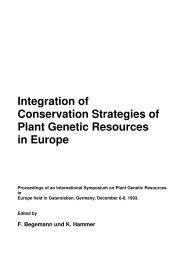Zugang zu Pflanzengenetischen Ressourcen für die ... - Genres
Zugang zu Pflanzengenetischen Ressourcen für die ... - Genres
Zugang zu Pflanzengenetischen Ressourcen für die ... - Genres
Erfolgreiche ePaper selbst erstellen
Machen Sie aus Ihren PDF Publikationen ein blätterbares Flipbook mit unserer einzigartigen Google optimierten e-Paper Software.
Survey of property rights and conditions of access to genetic resources on the international level<br />
Material found in nature that has not been manipulated or changed can generally not be protected<br />
as intellectual property, be it patents or plant breeders' rights. Derived material can be protected,<br />
precluding the provider of the base material from the use of the derivative.<br />
This has heightened concern among developing countries that when they provide genetic material<br />
to international genebanks which in turn make it freely available and allow genetic manipulations<br />
on that material the results of which can then be protected and will not be available to the<br />
providers of the original material, that this violates the spirit of the Biodiversity Convention.<br />
6 Issues Calling for Solution<br />
Three key problems call for immediate attention: access to new germplasm; the treatment of<br />
germplasm currently held in genebanks, and the thorny issue of farmers' rights. The last two<br />
aspects were left out from the Biodiversity Convention; and how they should be included is now<br />
being negotiated in FAO.<br />
6.1 Access to New Material<br />
A very serious concern is that the Biodiversity Convention will slow or impede the flow of genetic<br />
material, and with it, international research collaboration.<br />
Article 3 grants States "the sovereign right to exploit their own resources according to their own<br />
environmental policies", while Article 15 states: "Recognizing the sovereign rights of States over<br />
their national resources, the authority to determine access to genetic resources rests with the<br />
national governments and is subject to national legislation.“ This terminology goes well beyond<br />
the letter of the FAO Undertaking, even in the interpretation of the 1991 FAO Resolution, in that<br />
it denies a commitment to release and exchange germplasm. Article 15.2 merely requires a state<br />
to "endeavor to create conditions to facilitate access to genetic resources for environmentally<br />
sound uses... and not to impose restrictions that run counter to the objectives of [the]<br />
Convention".<br />
Some germplasm users may be unconcerned because (a) genetic material they need is already<br />
stored in genebanks and thus removed from the scope of the Convention; and (b) what is not in<br />
genebanks might be obtained outside the Convention since the export of genetic material is<br />
difficult, if not impossible, to police; a few seed grains are normally enough to export a variety.<br />
But many users, particularly in the biotechnology industry, seek systematic access to resources not<br />
yet collected and stored.<br />
The user community, following their different interests, is likely to react differently to the new<br />
situation. Industry will swiftly adjust to the new situation. Merck & Co, the largest U.S.<br />
pharmaceutical manufacturer, recently (and well before the approval of the Biodiversity










